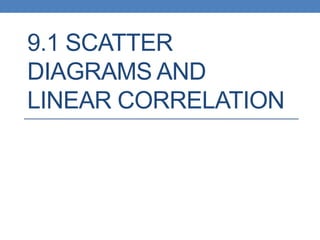9.1
•Als PPTX, PDF herunterladen•
5 gefällt mir•836 views
This document discusses scatter diagrams and linear correlation. It provides examples of scatter diagrams that do and do not show linear correlation. It defines the correlation coefficient r as a measure of linear correlation between two variables on a scatter plot, with values between -1 and 1. It presents formulas for calculating r and provides an example of computing r using wind velocity and sand drift rate data. It cautions that correlation does not necessarily imply causation and that lurking variables can influence the correlation between two variables.
Melden
Teilen
Melden
Teilen

Empfohlen
Empfohlen
Weitere ähnliche Inhalte
Was ist angesagt?
Was ist angesagt? (20)
Selecting, preparing, using and developing instructional materials

Selecting, preparing, using and developing instructional materials
Code of Ethics for Professional Teachers in the Philippines

Code of Ethics for Professional Teachers in the Philippines
Andere mochten auch
Andere mochten auch (20)
The use of Information and Communication Technology to support South African ...

The use of Information and Communication Technology to support South African ...
Ähnlich wie 9.1
Ähnlich wie 9.1 (20)
Mehr von leblance
Mehr von leblance (20)
9.1
- 1. 9.1 SCATTER DIAGRAMS AND LINEAR CORRELATION
- 3. Example 1: Scatter Diagram •
- 4. Example 1: Scatter Diagram Solution a) The values in the table make ordered pairs. To make the scatter diagram, scan the data and choose an appropriate scale for each axis. Phosphorous Reduction (100 mg/l) Figure 9.1 The line segment shows the basic trend.
- 5. Example 1: Scatter Diagram Solution •
- 6. Scatter Diagrams and Linear Correlation •
- 7. Scatter Diagrams and Linear Correlation • If the points of a scatter diagram are located so that NO line is realistically a “good” fit, then we say that the points possess no linear correlation. (a) (b) Scatter Diagrams with No Linear Correlation Figure 9.2
- 8. Scatter Diagrams and Linear Correlation
- 9. Scatter Diagrams and Linear Correlation Scatter Diagrams with Moderate and Perfect Linear Correlation Figure 9.4
- 10. Sample Correlation Coefficient r •
- 11. Sample Correlation Coefficient r •
- 12. Some facts about the Correlation Coefficient •
- 13. Formulas for r •
- 14. Formulas for r •
- 15. Example: Computing r • Sand driven by wind creates large, beautiful dunes at the Great Sand Dunes National Monument, Colorado. Of course, the same natural forces also create large dunes in the Great Sahara and Arabia. Is there a linear correlation between wind velocity and sand drift rate? Let x be a random variable representing wind velocity (in 10 cm/sec) and let y be a random variable representing drift rate of sand (in 100 gm/cm/sec). A test site at the Great Sand Dunes National Monument gave the following information about x and y (Reference: Hydrologic, Geologic, and Biologic Research at Great Sand Dunes National Monument, Proceedings of the National Park Service Research Symposium).
- 17. Causation • The correlation coefficient is a mathematical tool for measuring the strength of a linear relationship between two variables. • It makes no implication about cause or effect. • The fact that two variables tend to increase or decrease together does not mean that a change in one is causing a change in the other. • A strong correlation between x and y is sometimes due to other (either known or unknown) variables. Such variables are called lurking variables.